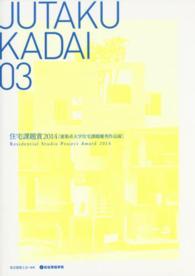- ホーム
- > 洋書
- > 英文書
- > Politics / International Relations
Full Description
During the "Orange Revolution" in Ukraine, the second largest country in Europe came close to a violent break-up similar to that in neighboring Moldova, which witnessed a violent secession of the Transdniestria region. Numerous elections, including the hotly contested 2004 presidential elections in Ukraine, and surveys of public opinion showed significant regional divisions in these post-Soviet countries. Western parts of Ukraine and Moldova, as well as the Muslim Crimean Tatars, were vocal supporters of independence, nationalist, and pro-Western parties and politicians. In contrast, Eastern regions, as well as the Orthodox Turkic-speaking Gagauz, consistently expressed pro-Russian and pro-Communist political orientations. Which factors-historical legacies, religion, economy, ethnicity, or political leadership-could explain these divisions? Why was Ukraine able to avoid a violent break-up, in contrast to Moldova? This is the first book to offer a systematic and comparative analysis of the regional political divisions in post-Soviet Ukraine and Moldova.
The study examines voting behavior and political attitudes in two groups of regions: those which were under Russian, Ottoman, and Soviet rule; and those which were under Austro-Hungarian, Polish, Romanian, and Czechoslovak rule until World War I or World War II. This book attributes the regional political divisions to the differences in historical experience. This study helps us to better understand regional cleavages and conflicts, not only in Ukraine and Moldova, but also in other cleft countries.
Contents
List of Tables, Figures, and Pictures Foreword by Francis Fukuyama Acknowledgements 1. Introduction 2. Cleft countries: A theoretical and comparative framework 3. Regional political divisions in post-Communist Ukraine and Moldova 4. Evolution of regional political cultures in Ukraine and Moldova 5. Culture, ethnicity, economy, and political leadership 6. Conclusion Appendices Bibliography Index
-

- 電子書籍
- 我が名は海師(4)







